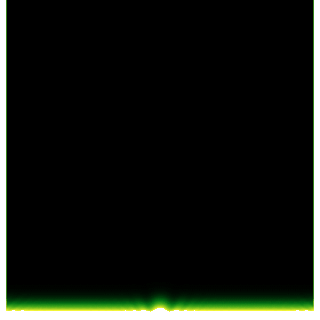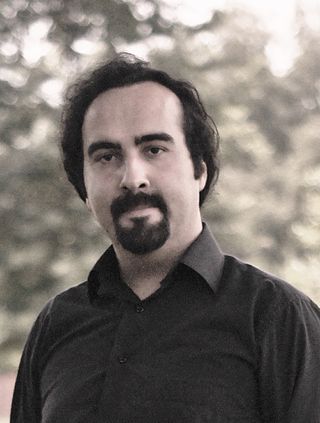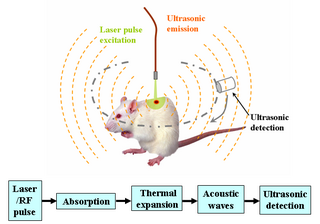
Ultrasound is sound with frequencies greater than 20 kilohertz. This frequency is the approximate upper audible limit of human hearing in healthy young adults. The physical principles of acoustic waves apply to any frequency range, including ultrasound. Ultrasonic devices operate with frequencies from 20 kHz up to several gigahertz.

Elastography is any of a class of medical imaging modalities that map the elastic properties and stiffness of soft tissue. The main idea is that whether the tissue is hard or soft will give diagnostic information about the presence or status of disease. For example, cancerous tumours will often be harder than the surrounding tissue, and diseased livers are stiffer than healthy ones.
Time reversal signal processing is a signal processing technique that has three main uses: creating an optimal carrier signal for communication, reconstructing a source event, and focusing high-energy waves to a point in space. A Time Reversal Mirror (TRM) is a device that can focus waves using the time reversal method. TRMs are also known as time reversal mirror arrays since they are usually arrays of transducers. TRM are well-known and have been used for decades in the optical domain. They are also used in the ultrasonic domain.

Contrast-enhanced ultrasound (CEUS) is the application of ultrasound contrast medium to traditional medical sonography. Ultrasound contrast agents rely on the different ways in which sound waves are reflected from interfaces between substances. This may be the surface of a small air bubble or a more complex structure. Commercially available contrast media are gas-filled microbubbles that are administered intravenously to the systemic circulation. Microbubbles have a high degree of echogenicity. There is a great difference in echogenicity between the gas in the microbubbles and the soft tissue surroundings of the body. Thus, ultrasonic imaging using microbubble contrast agents enhances the ultrasound backscatter, (reflection) of the ultrasound waves, to produce a sonogram with increased contrast due to the high echogenicity difference. Contrast-enhanced ultrasound can be used to image blood perfusion in organs, measure blood flow rate in the heart and other organs, and for other applications.

High-intensity focused ultrasound (HIFU) is a non-invasive therapeutic technique that uses non-ionizing ultrasonic waves to heat or ablate tissue. HIFU can be used to increase the flow of blood or lymph or to destroy tissue, such as tumors, via thermal and mechanical mechanisms. Given the prevalence and relatively low cost of ultrasound generation mechanisms, The premise of HIFU is that it is expect a non-invasive and low-cost therapy that can at minimum outperform operating room care.
A parametric array, in the field of acoustics, is a nonlinear transduction mechanism that generates narrow, nearly side lobe-free beams of low frequency sound, through the mixing and interaction of high frequency sound waves, effectively overcoming the diffraction limit associated with linear acoustics. The main side lobe-free beam of low frequency sound is created as a result of nonlinear mixing of two high frequency sound beams at their difference frequency. Parametric arrays can be formed in water, air, and earth materials/rock.

A Bessel beam is a wave whose amplitude is described by a Bessel function of the first kind. Electromagnetic, acoustic, gravitational, and matter waves can all be in the form of Bessel beams. A true Bessel beam is non-diffractive. This means that as it propagates, it does not diffract and spread out; this is in contrast to the usual behavior of light, which spreads out after being focused down to a small spot. Bessel beams are also self-healing, meaning that the beam can be partially obstructed at one point, but will re-form at a point further down the beam axis.

Ultrasonic transducers and ultrasonic sensors are devices that generate or sense ultrasound energy. They can be divided into three broad categories: transmitters, receivers and transceivers. Transmitters convert electrical signals into ultrasound, receivers convert ultrasound into electrical signals, and transceivers can both transmit and receive ultrasound.
The ASA Silver Medal is an award presented by the Acoustical Society of America to individuals, without age limitation, for contributions to the advancement of science, engineering, or human welfare through the application of acoustic principles or through research accomplishments in acoustics. The medal is awarded in a number of categories depending on the technical committee responsible for making the nomination.
Acoustic radiation force (ARF) is a physical phenomenon resulting from the interaction of an acoustic wave with an obstacle placed along its path. Generally, the force exerted on the obstacle is evaluated by integrating the acoustic radiation pressure over its time-varying surface.
In acoustics, acoustic attenuation is a measure of the energy loss of sound propagation through an acoustic transmission medium. Most media have viscosity and are therefore not ideal media. When sound propagates in such media, there is always thermal consumption of energy caused by viscosity. This effect can be quantified through the Stokes's law of sound attenuation. Sound attenuation may also be a result of heat conductivity in the media as has been shown by G. Kirchhoff in 1868. The Stokes-Kirchhoff attenuation formula takes into account both viscosity and thermal conductivity effects.
Piezoelectric Micromachined Ultrasonic Transducers (PMUT) are MEMS-based piezoelectric ultrasonic transducers. Unlike bulk piezoelectric transducers which use the thickness-mode motion of a plate of piezoelectric ceramic such as PZT or single-crystal PMN-PT, PMUT are based on the flexural motion of a thin membrane coupled with a thin piezoelectric film, such as PVDF. In comparison with bulk piezoelectric ultrasound transducers, PMUT can offer advantages such as increased bandwidth, flexible geometries, natural acoustic impedance match with water, reduced voltage requirements, mixing of different resonant frequencies and potential for integration with supporting electronic circuits especially for miniaturized high frequency applications.

Timothy Grant Leighton is the Professor of Ultrasonics and Underwater Acoustics at the University of Southampton. He is the inventor-in-chief of Sloan Water Technology Ltd., a company founded around his inventions. He is an academician of three national academies. Trained in physics and theoretical physics, he works across physical, medical, biological, social and ocean sciences, fluid dynamics and engineering. He joined the Institute of Sound and Vibration Research (ISVR) at the University of Southampton in 1992 as a lecturer in underwater acoustics, and completed the monograph The Acoustic Bubble in the same year. He was awarded a personal chair at the age of 35 and has authored over 400 publications.
Floyd Alburn Firestone (1898–1986) was an acoustical physicist, who in 1940 while a professor at the University of Michigan invented the first practical ultrasonic testing method and apparatus. He was granted U.S. Patent 2,280,226 for the invention in 1942. Manufactured by Sperry Corporation, the testing device was known variously as the Firestone-Sperry Reflectoscope, the Sperry Ultrasonic Reflectoscope, the Sperry Reflectoscope and sometimes also just as a Supersonic Reflectoscope, the name Firestone had coined for the instrument. The technology is not just used in quality control in factories to reject defective parts before shipment, but also revolutionized transportation safety. For example, ultrasonic testing is used for safety maintenance inspection of railroad cars, particularly axles and wheels, aircraft, particularly fuselages, and other transportation vessels for material fatigue. Dr. Firestone's ultrasonic pulse echo technique for metal defect testing was also later applied in medical diagnosis, giving birth to the field of Echocardiography and to the field of Medical Ultrasonography, generally. Dr. Firestone was the editor of the Journal of the Acoustical Society of America from 1939 to 1957. Among Firestone's many other inventions, were in a single year an “automatic device for the minute inspection of flaws”, “a new and useful improvement in hook-up of electrical apparatus”, and “[a] device for measuring noise”, and, even, later a “musical typewriter”.

Alper Erturk is a mechanical engineer and the Woodruff Professor in the George W. Woodruff School of Mechanical Engineering at Georgia Institute of Technology.

Functional ultrasound imaging (fUS) is a medical ultrasound imaging technique of detecting or measuring changes in neural activities or metabolism, for example, the loci of brain activity, typically through measuring blood flow or hemodynamic changes. The method can be seen as an extension of Doppler imaging.
Ultrasonic algae control is a commercial technology that has been claimed to control the blooming of cyanobacteria, algae, and biofouling in lakes, and reservoirs, by using pulsed ultrasound. The duration of such treatment is supposed to take up to several months, depending on the water volume and algae species. Despite the experimental demonstration of certain bioeffects in small samples under controlled laboratory and sonication conditions, there is no scientific foundation for outdoors ultrasonic algae control.

Deep learning in photoacoustic imaging combines the hybrid imaging modality of photoacoustic imaging (PA) with the rapidly evolving field of deep learning. Photoacoustic imaging is based on the photoacoustic effect, in which optical absorption causes a rise in temperature, which causes a subsequent rise in pressure via thermo-elastic expansion. This pressure rise propagates through the tissue and is sensed via ultrasonic transducers. Due to the proportionality between the optical absorption, the rise in temperature, and the rise in pressure, the ultrasound pressure wave signal can be used to quantify the original optical energy deposition within the tissue.

Laszlo Adler is an American physicist and a Taine McDougal Professor Emeritus in the Department of Integrated Systems Engineering at the Ohio State University. He is known for his work in Ultrasonics, Acousto-optics, and Nondestructive Evaluation of Materials. He is a holocaust survivor and has been active in scientific research for over 60 years.
Gregg E. Trahey is an American biomedical engineer and academic in the field of medical ultrasound. He is the Robert Plonsey Distinguished Professor of Biomedical Engineering at Duke University. In 2022, he was named a fellow of the Institute of Electrical and Electronics Engineers (IEEE) "for contributions to speckle tracking and acoustic radiation force impulse imaging in medical ultrasound".











